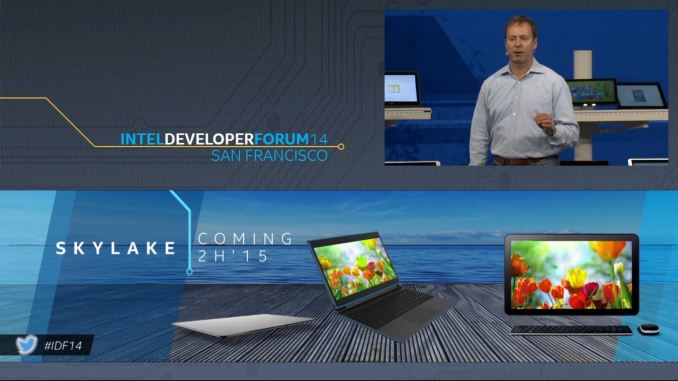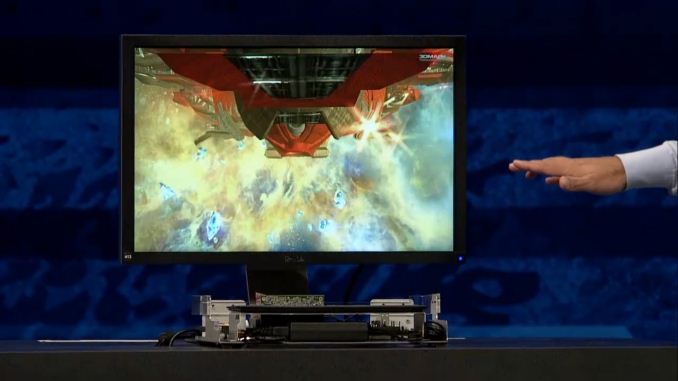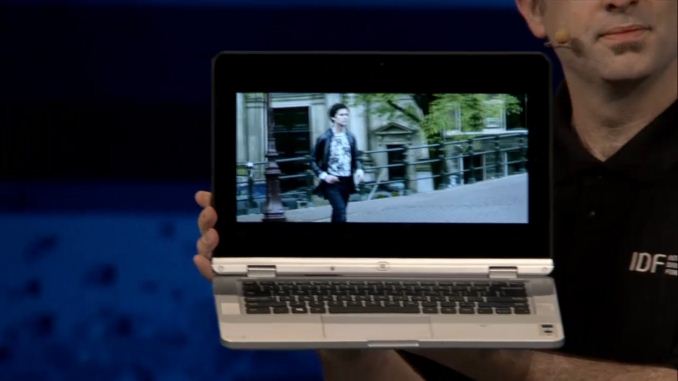IDF 2014: Intel Demonstrates Skylake, Due H2’2015
by Ryan Smith on September 9, 2014 7:30 PM EST
Taking place this week alongside the consumer electronics clamor is the annual Intel Developer Forum (IDF) at the Moscone Center in San Francisco. Though it has and continues to be first and foremost a developers conference, IDF also offers Intel a chance to unveil new products, and in more recent editions discuss and promote their plans for further breaking into the mobile market.
Diving right into the subject of Intel’s Core microarchitecture, with the Broadwell based Core M already in the process of launching, Intel is giving developers and the public a look at what comes after Broadwell. Already on Intel’s roadmaps for some time, Intel took to the stage at IDF14 to formally announce their next-generation Skylake architecture and to demonstrate its status.
| Intel's Tick-Tock Cadence | |||||
| Microarchitecture | Process Node | Tick or Tock | Release Year | ||
| Conroe/Merom | 65nm | Tock | 2006 | ||
| Penryn | 45nm | Tick | 2007 | ||
| Nehalem | 45nm | Tock | 2008 | ||
| Westmere | 32nm | Tick | 2010 | ||
| Sandy Bridge | 32nm | Tock | 2011 | ||
| Ivy Bridge | 22nm | Tick | 2012 | ||
| Haswell | 22nm | Tock | 2013 | ||
| Broadwell | 14nm | Tick | 2014 | ||
| Skylake | 14nm | Tock | 2015 | ||
In Intel terminology Skylake is the Tock to Broadwell’s Tick, offering a new microarchitecture atop the 14nm process first introduced with Broadwell. As is the case with every Core update, for Skylake Intel is shooting for significant increases in performance, power efficiency, and battery life. Since Skylake is built on the same 14nm process as Broadwell, Skylake is primarily an exercise in Intel’s architecture development capabilities, with its gains needing to come from optimizations in design rather than significant manufacturing improvements.
At roughly a year out from launch Intel is not saying anything about the architecture or design at this time, but they are using IDF to showcase that Skylake is up and running. Demonstrating this, Intel showcased a pair of Skylake development systems. The first of which was a traditional open laboratory testbed that was running 3DMark, which was being used to showcase that the GPU and CPU portions of Skylake were running and performing well. The second demonstration was a completed laptop that was playing back 4K video, and is an early version of the hardware Intel will be shipping as the software development vehicle for developers next year.
Alongside their demonstration, Intel also announced a rough timeline for the volume production and availability of Skylake. Volume production will take place in H2’2015, with product availability slated for later in the year. With Broadwell being behind schedule due to a slower than planned bring-up of their 14nm process, there has been some question over what would happen with Skylake and Intel clearly wanted to address this head-on.
Consequently a big part of Intel’s message on Skylake is that the next generation CPU is already up and running and is in a healthy state, apparently unfazed by the earlier 14nm delays that dogged Broadwell. At the same time the H2’2015 launch date for Skylake means that it’s going to be out roughly a year after the first Broadwell parts, which means Intel still intends to adhere to their roughly 1 year product replacement cadence.












33 Comments
View All Comments
MikeMurphy - Wednesday, September 10, 2014 - link
IPC improvement only if it means power savings. Intel seems determined to win the mobile crown for all devices, and has the resources and minds to do it.MrSpadge - Wednesday, September 10, 2014 - link
On average Ivy was about 6% faster than Sandy, Haswell 8% than Ivy and Broadwell is supposed to provide about another 6% IPC boost. Don't expect more than 10% from Skylake, as the current architecture is already extremely good.Stochastic - Tuesday, September 9, 2014 - link
Also, I wonder if Intel will be pushing IGP performance more heavily this time around. The past few generations have seen decent improvements generation to generation, but I don't get the impression that graphics performance has been Intel's top priority. Might we see a more substantive IGP architecture tweak this time around than what we'll be seeing with Broadwell?ImKant - Sunday, September 14, 2014 - link
You can't be serious. Their IGPs are growing by leaps and bounds.wintermute000 - Tuesday, September 9, 2014 - link
I'm waiting to see the PCIE lane armageddon that semiaccurate has been predicting. If they cut the legs out from gamers / dGPU users who don't want to pay the big premium for the Pro platform then it might just be an opportunity for the red team, if they get their act togetherBecause0789 - Wednesday, September 10, 2014 - link
Is that based off those 2 year old rumors that Broad well was gonna be BGA only as well? A quick look at the Broadwell wiki shows both LGA 1150 and BGA SKUsrhx123 - Wednesday, September 10, 2014 - link
It will probably not happen in desktops, but I wouldn't be surprised if it gets scaled back in laptops again.We lost the 16x3.0 lanes with Haswell ULV, what's to say they won't chop it off for the lower end i3s and i5s, forcing dGPU laptops to be paired with expensive i7s?
The loss of dGPUs on Haswell ULV was a kicker for thin laptops with dedicated GPUs, as something like a 840m won't suffer from being paired with a ULV chip, yet the combination would have a much lower TDP.
DanNeely - Wednesday, September 10, 2014 - link
I don't recall seeing anything about full power mobile CPUs; but the rumors I've seen for desktop Skylake have been an increase to 20 lanes on the CPU (16GPU, + 4 SSD). I suppose it's possible that they might drop the full power mobile version down to 12 (8 + 4); but am somewhat skeptical because the OEMs who do SLI laptops and RAID0 SSDs would howl.Haswell ULV could pair the 840 on 4 PCIe lanes from the CPU if the OEM wanted to, or even doe something silly like 2x840's in SLI with 4 lanes each (Intel's specsheet implies that you can't group 8 lanes into a single connection). A GPU of that class wouldn't bottleneck on the narrower bus; so I can only assume that the SNB ULV gaming laptops didn't sell well enough to justify continued investment.
extide - Saturday, September 13, 2014 - link
I HIGHLY doubt that the PCI-E lane cut happens on desktop / std mobile parts. I mean, there are rumors of 20 pcie lanes on desktop skylake (instead of the current 16). Time will tell...kenoh - Wednesday, September 10, 2014 - link
Will the IPC be really that impressive? Aren't they wrong about Skylake coming out one year after Broadwell? Their suppose to come out together, right?Any time frame for Skylake-E? because that would be my next upgrade from my Ivy Bridge-E 4930k